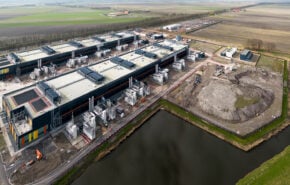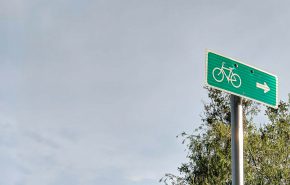Jacob Burns, PLA, ASLA is one of hundreds of skilled GAI professionals who help clients create better communities, transportation infrastructure, energy generation and delivery, and more from our office locations throughout the United States. Today we’ll find out a little about what makes Jacob tick—the background, motivation, and methods that he brings to the table every day for GAI and GAI’s clients.
Q: Please tell us a little about how you arrived at your area of specialization.
Jacob Burns: I came into landscape architecture almost accidentally. During a campus tour of West Virginia University, my guide asked if anyone was interested in Landscape Architecture. I was only vaguely aware of the field at the time—yet the moment my guide brought me into the Landscape Architecture studio I realized that I had found a perfect way to blend my creativity and love for nature. I had found my calling and the rest is history.
I have been practicing professionally for a little over 8 years now, the majority of that time with GAI. Before GAI, I interned with a local civil engineering firm, which gave me great background that I still draw upon today. I did a lot of surveying and construction inspection in that previous role, primarily involving water and wastewater related systems—yet I sought a position in which I could fully utilize my Landscape Architecture degree. I found that opportunity at GAI.
Q: What role do you play at GAI, and what sorts of projects do you typically contribute to?
Jacob: Landscape Architecture includes such a broad scope of expertise that it is difficult to categorize the type of roles I may play or projects I may work on. On one project, I may focus primarily on a landscape plan, whereas on another project I will be involved from concept development all the way through drainage design. A large part of my work during my time at GAI has been related to parks and recreation, which is common among landscape architects. In particular, I have worked on several sports and athletic complexes over the last few years, and it appears that more are on the horizon. My role was largely production based during my first few years at GAI, and as I have gained more experience, I have started to take on task and project management roles. These roles have me working directly with our clients to make sure their goals are met during the project—these interactions may take place anywhere from the conceptual design stage all the way through meeting challenges that may arise during construction administration.
Q: What do you like most about your job, and why do you feel GAI is a good place to put your skills to work?
We are fortunate to work on a variety of projects at GAI, which is one of the things I like most about my job. One week we’re designing a park, the next week we’re assisting in updating a comprehensive plan for a local municipality. Not doing the same thing every day is a big plus for me.
I believe that GAI’s ability to offer a full range of services to clients is one of our company’s greatest strengths. This puts us in a good position to win additional work if we’re able to get in on the ground floor, so to speak. For instance, GAI’s Cultural Resources team may be brought in to review a site that a client is interested in developing. When the site has been reviewed, the Landscape Architecture team is able to step in to pick up where Cultural Resources left off and start designing. And if Cultural Resources had identified any sensitive situations during their review, we are able to work with them and design the site accordingly. That is a simplified example, of course, but very indicative of how the different skillsets at GAI come together to meet project challenges for our clients in a quick, collaborative, and comprehensive way.
At each level, being mindful of a community’s unique sense of place and addressing its residents’ everyday needs benefits a wide range of people, and it’s gratifying to have a hand in helping create enhanced, better-connected communities.
Q: How do you measure your success?
Repeat work is one of my favorite indicators of project success. I work hard to maintain relationships with our clients well after the project is done. With our parks and recreation clients, I try to attend their events to make sure there is a face to connect with a name that they associate with GAI. This, in my opinion, has been a big help in getting GAI repeat work with those clients.
I also pride myself on being highly responsive to client questions related to projects we designed. In one example, there was some turnover of municipal staff connected to a large park facility that we designed. I was able to meet with the new maintenance director and walk them through our design documents to help them get their bearings and understand how to keep everything running smoothly. To see how that works at a very specific level, I was able to help the client track down the circuit of a particular parking lot light so they could turn the light off for a movie night in the park!
Q: How do you feel that the job you do at GAI benefits the community and the world?
I grew up in a community that largely lacked sidewalks. It wasn’t until I was in college that a state road widening project funded the addition of basic sidewalks along the town’s main road. Having walked along that road when I was young, trying to figure out how to get where I was going safely before I had a car, really made me appreciate how much the sidewalks improved connectivity within our community. Since the sidewalks were built, the town has started to host pedestrian-centric events and the small downtown area has blossomed quite a bit. Seeing this transformation increased my passion for basic connectivity and how it benefits the community as a whole, which is something I strive to include in all of my work.
At the core of many of the GAI projects I take part in, we are working to create and improve spaces for humans. This can be as simple as building a sidewalk to help kids walk safely to school, or as complex as designing the exterior of a convention center. At each level, being mindful of a community’s unique sense of place and addressing its residents’ everyday needs benefits a wide range of people, and it’s gratifying to have a hand in helping create enhanced, better-connected communities.
Jacob Burns, PLA, ASLA is a member of GAI’s Community Solutions Group (CSG), a multifaceted practice committed to creating rich, diverse, sustainable, authentic places that allow people to connect to the environment, the community, and each other. Contact Jacob at 681.245.8858 and find out more about what GAI’s CSG can do for your community—message GAI online and start the conversation about how our multidiscipline professionals can meet your unique project needs.
![]() Jacob Burns’ diverse experience includes a strong emphasis on streetscape enhancement, urban connectivity, and recreational space design. Mr. Burns holds a Bachelor of Science degree in landscape architecture from West Virginia University and is an active member in the West Virginia chapter of the American Society of Landscape Architects
Jacob Burns’ diverse experience includes a strong emphasis on streetscape enhancement, urban connectivity, and recreational space design. Mr. Burns holds a Bachelor of Science degree in landscape architecture from West Virginia University and is an active member in the West Virginia chapter of the American Society of Landscape Architects


